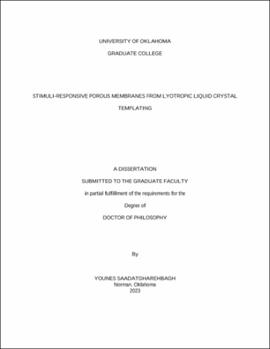| dc.description.abstract | Lyotropic liquid crystal (LLC) templating is an efficient approach to synthesize nanostructured polymers with a wide range of applications, particularly in molecular separation. LLCs offer diverse nanostructures, but we focus on the lamellar and normal hexagonal phases due to their ability to facilitate continuous transport paths in two and three dimensions, respectively. This feature is particularly advantageous for membrane applications. The normal hexagonal phase is especially desirable as it eliminates the need for structural alignment. This dissertation presents a comprehensive investigation of transcriptive and synergistic LLC templating approaches for synthesizing stimuli-responsive membranes. These membranes can alter their separation performance in response to external stimuli such as temperature and pH.
When it comes to transcriptive LLC templating, the preservation of the LLC structure after polymerization is highly dependent on polymerization kinetics. Therefore, this dissertation examines the initiator-dependent thermal polymerization kinetics in LLC templates. The results indicate that both water-soluble and oil-soluble initiators effectively preserve the structure after the reaction. However, the use of a water-soluble initiator not only results in higher polymerization rates but also enhances the mechanical properties of the synthesized polymer. Transcriptive templating enables the production of two-step thermoresponsive ultrafiltration (UF) membranes by employing the water-soluble initiator. Thermoresponsive Pluronic F127 (F127) block copolymer is utilized to initiate the thermal response in this study. The formation of an LLC with lamellar structure is achieved by combining the F127 block copolymer with water and hydrophobic monomers. Subsequently, polymerization leads to the creation of a cross-linked network that effectively immobilizes the F127 molecules. The resulting membrane exhibits adjustable pore sizes, ranging from 34.6 nm to 45.7 nm and 59.6 nm, as the temperature is increased from 25 °C to 35 °C and 50 °C, respectively. Consequently, the membrane permeability is enhanced and molecular weight cutoff (MWCO) can be controlled. The observed two-step thermal response is attributed to the lower critical solution temperature (LCST) of F127 at 35 °C and the melting of the crystalline structure of its PEO bock at 50 °C. The results show that conducting membrane cleaning procedures at higher temperatures can enhance cleaning efficiency and prolong the lifespan of the membrane. This approach takes advantage of the temperature-dependent changes in porosity.
Synergistic LLC templating is employed using in-lab-synthesized polymerizable Pluronic P84 surfactant to produce H1-structured thermoresponsive ultrafiltration (UF) and nanofiltration (NF) membranes. Our research findings reveal that the synthesized membrane exhibits remarkable adaptability, as evidenced by its ability to modulate thickness-normalized flux from 28 to 68 liters m−2 hour−1 µm and pore size from 2.5 to 3.2 nm when the temperature is raised from 25 to 45 °C, respectively. Moreover, the membrane demonstrates exceptional resistance to fouling, as its permeability remains largely unaffected even after 60 h of filtering charged and uncharged solutes. This outstanding antifouling behavior is attributed to the highly hydrophilic surface of the membrane. The addition of acrylic acid (AAc) to the LLC formulation allows for the incorporation of additional functionality into this membrane. The resulting membrane exhibits the capability to effectively separate dissolved salts containing trivalent and divalent anion from water. Furthermore, it demonstrates both pH-responsive and thermoresponsive behaviors. By increasing the temperature from 25 to 45 °C, the membrane has the capability to alter its pore size from 2.2 to 2.6 nm, along with adjusting its thickness-normalized flux from 16 to 31 liters m−2 hour−1 µm, respectively. The membrane effectively removes salts containing trivalent and divalent anion under neutral and alkaline pH conditions, with the option to turn off its ion rejection capability by reducing the feed pH to 4. Additionally, the membrane displays remarkable selectivity for sulfate ions over chloride ions, making it an ideal choice for salt fractionation applications. Our work on synergistic LLC templating has not only expanded the range of achievable membrane pore sizes through this approach but also successfully produced stimuli-responsive H1-structured polyLLC membranes, which is a unique accomplishment. | en_US |

